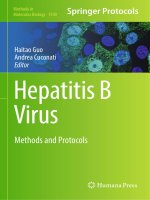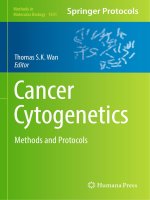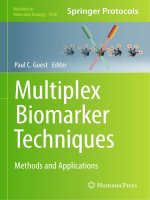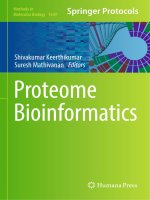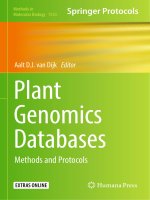Methods in molecular biology vol 1541 cancer cytogenetics methods and protocols
Bạn đang xem bản rút gọn của tài liệu. Xem và tải ngay bản đầy đủ của tài liệu tại đây (9.86 MB, 339 trang )
Methods in
Molecular Biology 1541
Thomas S.K. Wan
Editor
Cancer
Cytogenetics
Methods and Protocols
METHODS
IN
MOLECULAR BIOLOGY
Series Editor
John M. Walker
School of Life and Medical Sciences
University of Hertfordshire
Hatfield, Hertfordshire, AL10 9AB, UK
For further volumes:
/>
Cancer Cytogenetics
Methods and Protocols
Edited by
Thomas S.K. Wan
Haematology Division, Department of Anatomical and Cellular Pathology,
The Chinese University of Hong Kong, Prince of Wales Hospital, Shatin, Hong Kong, China
Editor
Thomas S.K. Wan
Haematology Division
Department of Anatomical and Cellular Pathology
The Chinese University of Hong Kong
Prince of Wales Hospital
Shatin, Hong Kong, China
ISSN 1064-3745
ISSN 1940-6029 (electronic)
Methods in Molecular Biology
ISBN 978-1-4939-6701-8
ISBN 978-1-4939-6703-2 (eBook)
DOI 10.1007/978-1-4939-6703-2
Library of Congress Control Number: 2016958568
© Springer Science+Business Media LLC 2017
This work is subject to copyright. All rights are reserved by the Publisher, whether the whole or part of the material is
concerned, specifically the rights of translation, reprinting, reuse of illustrations, recitation, broadcasting, reproduction
on microfilms or in any other physical way, and transmission or information storage and retrieval, electronic adaptation,
computer software, or by similar or dissimilar methodology now known or hereafter developed.
The use of general descriptive names, registered names, trademarks, service marks, etc. in this publication does not
imply, even in the absence of a specific statement, that such names are exempt from the relevant protective laws and
regulations and therefore free for general use.
The publisher, the authors and the editors are safe to assume that the advice and information in this book are believed to
be true and accurate at the date of publication. Neither the publisher nor the authors or the editors give a warranty,
express or implied, with respect to the material contained herein or for any errors or omissions that may have been made.
Printed on acid-free paper
This Humana Press imprint is published by Springer Nature
The registered company is Springer Science+Business Media LLC
The registered company address is: 233 Spring Street, New York, NY 10013, U.S.A.
Preface
The discovery of the Philadelphia chromosome in 1960 ushered the field of cancer cytogenetics study into a new era. The development of fluorescence in situ hybridization (FISH)
in 1980 helped to overcome many of the drawbacks in the assessment of genetic alterations
in cancer cells by karyotyping. Subsequent methodological advances in molecular cytogenetics that were initiated in the early 1990s based on the principle of FISH have greatly
enhanced the efficiency and accuracy of karyotype analysis by marrying conventional cytogenetics with molecular technologies. All of these molecular cytogenetic techniques add
colors to the monotonous world of conventional chromosome banding. Currently, both
karyotyping and FISH studies have emerged as indispensable tools for both basic and clinical research, which parallel their clinical diagnostic application in leukemia and cancers. The
development, current utilization, detailed hands-on protocols, data interpretation, and
technical pitfalls of these approaches used for cancer diagnosis and research will be included
in this volume of book.
This volume Cancer Cytogenetics: Methods and Protocols of the Springer Methods in
Molecular Biology series provides the readers with detailed protocols covering the main
cancer cytogenetics techniques needed for clinical utilization and research purposes.
Updated reviews on the recurrent chromosomal abnormalities in hematological malignancies provide an excellent, helpful benchmarking guide for cytogenetics data interpretation
and specific malignant diseases correlation. All chapters were precisely written by professionally experienced cytogeneticists and/or pathologists working proactively in this specialized field. I have been very fortunate to have gathered a group of 52 experts from 15
countries or cities, including Australia, Canada, China, France, Germany, Hong Kong,
Italy, Korea, the Netherlands, Poland, Russia, Singapore, Thailand, the United Kingdom,
and the United States of America, in a short period of time to share their experiences empathetically and interactively. Although the circle of cancer cytogeneticists is relatively small,
its task is notably significant, fostering worldwide contribution and collaboration. I would
like to thank all of them for their generous contributions to this volume of book. In addition to the step-by-step description of every technique, much emphasis is placed on the
pitfalls that accompany all testing procedures.
This book is intended for use by the novice in cytogenetics, providing helpful guiding
protocols to them as well as deeper insights to those who are already engaged in the field,
yet looking for some technical hints.
I am grateful to all colleagues in Cytogenetics Laboratory, Division of Haematology,
Department of Anatomical and Cellular Pathology, The Chinese University of Hong Kong,
Prince of Wales Hospital, under whose auspices this book was written. I would also like to
thank Professor Ka-Fai To and Professor Margaret H. L. Ng for their continued encouragement. Last but not the least, I wish to express my thankful indebtedness to my wife, Mary,
and my two sons, Conan and Eden, for their support and patience.
Hong Kong, China
Thomas S.K. Wan, PhD, FRCPath, FFSc(RCPA)
v
Contents
Preface . . . . . . . . . . . . . . . . . . . . . . . . . . . . . . . . . . . . . . . . . . . . . . . . . . . . . . . . . . . . . . . . . . . . . . . . . . . . . . . . . . . . . . .
Contributors . . . . . . . . . . . . . . . . . . . . . . . . . . . . . . . . . . . . . . . . . . . . . . . . . . . . . . . . . . . . . . . . . . . . . . . . . . . . . . . . .
v
ix
1 Cancer Cytogenetics: An Introduction . . . . . . . . . . . . . . . . . . . . . . . . . . . . . . . . . . . . . . . . . . . . . .
Thomas S.K. Wan
2 Chromosome Preparation for Myeloid Malignancies. . . . . . . . . . . . . . . . . . . . . . . . . . . . . . .
Eleanor K.C. Hui, Thomas S.K. Wan, and Margaret H.L. Ng
3 Chromosome Preparation for Acute Lymphoblastic Leukemia . . . . . . . . . . . . . . . . . . .
Mary Shago
4 Chromosome Preparation for Chronic Lymphoid Malignancies . . . . . . . . . . . . . . . . . .
Dorota Koczkodaj and Agata A. Filip
5 Cytogenetic Harvesting of Cancer Cells and Cell Lines . . . . . . . . . . . . . . . . . . . . . . . . . . .
Roderick A.F. MacLeod, Maren E. Kaufmann, and Hans G. Drexler
6 Chromosome Bandings . . . . . . . . . . . . . . . . . . . . . . . . . . . . . . . . . . . . . . . . . . . . . . . . . . . . . . . . . . . . . . .
Huifang Huang and Jiadi Chen
7 Chromosome Recognition . . . . . . . . . . . . . . . . . . . . . . . . . . . . . . . . . . . . . . . . . . . . . . . . . . . . . . . . . . .
Thomas S.K. Wan, Eleanor K.C. Hui, and Margaret H.L. Ng
8 Applications of Fluorescence In Situ Hybridization Technology
in Malignancies . . . . . . . . . . . . . . . . . . . . . . . . . . . . . . . . . . . . . . . . . . . . . . . . . . . . . . . . . . . . . . . . . . . . . . . .
Montakarn Tansatit
9 Fluorescence In Situ Hybridization Probe Preparation . . . . . . . . . . . . . . . . . . . . . . . . . . . .
Doron Tolomeo, Roscoe R. Stanyon, and Mariano Rocchi
10 Fluorescence In Situ Hybridization Probe Validation for Clinical Use . . . . . . . . . . .
Jun Gu, Janice L. Smith, and Patricia K. Dowling
11 Fluorescence In Situ Hybridization on Tissue Sections . . . . . . . . . . . . . . . . . . . . . . . . . . . .
Alvin S.T. Lim and Tse Hui Lim
12 Cytoplasmic Immunoglobulin Light Chain Revelation
and Interphase Fluorescence In Situ Hybridization in Myeloma . . . . . . . . . . . . . . . . . .
Sarah Moore, Jeffrey M. Suttle, and Mario Nicola
13 Quantitative Fluorescence In Situ Hybridization (QFISH) . . . . . . . . . . . . . . . . . . . . . . .
Ivan Y. Iourov
14 High Resolution Fiber-Fluorescence In Situ Hybridization . . . . . . . . . . . . . . . . . . . . . . .
Christine J. Ye and Henry H. Heng
15 Array-Based Comparative Genomic Hybridization (aCGH) . . . . . . . . . . . . . . . . . . . . . .
Chengsheng Zhang, Eliza Cerveira, Mallory Romanovitch, and Qihui Zhu
16 Multicolor Karyotyping and Fluorescence In Situ Hybridization-Banding
(MCB/mBAND) . . . . . . . . . . . . . . . . . . . . . . . . . . . . . . . . . . . . . . . . . . . . . . . . . . . . . . . . . . . . . . . . . . . . . .
Thomas Liehr, Moneeb A.K. Othman, and Katharina Rittscher
1
vii
11
19
33
43
59
67
75
91
101
119
127
143
151
167
181
viii
Contents
17 Cytogenetics for Biological Dosimetry . . . . . . . . . . . . . . . . . . . . . . . . . . . . . . . . . . . . . . . . . . . . . .
Michelle Ricoul, Tamizh Gnana-Sekaran, Laure Piqueret-Stephan,
and Laure Sabatier
18 Recurrent Cytogenetic Abnormalities in Myelodysplastic Syndromes . . . . . . . . . . . .
Meaghan Wall
19 Recurrent Cytogenetic Abnormalities in Acute Myeloid Leukemia . . . . . . . . . . . . . . .
John J. Yang, Tae Sung Park, and Thomas S.K. Wan
20 Recurrent Cytogenetic Abnormalities in Myeloproliferative Neoplasms
and Chronic Myeloid Leukemia. . . . . . . . . . . . . . . . . . . . . . . . . . . . . . . . . . . . . . . . . . . . . . . . . . . . . .
John Swansbury
21 Recurrent Cytogenetic Abnormalities in Acute Lymphoblastic Leukemia . . . . . . .
Mary Shago
22 Recurrent Cytogenetic Abnormalities in Non-Hodgkin’s Lymphoma
and Chronic Lymphocytic Leukemia . . . . . . . . . . . . . . . . . . . . . . . . . . . . . . . . . . . . . . . . . . . . . . . .
Edmond S.K. Ma
23 Recurrent Cytogenetic Abnormalities in Multiple Myeloma . . . . . . . . . . . . . . . . . . . . . .
Nelson Chun Ngai Chan and Natalie Pui Ha Chan
24 Cytogenetic Nomenclature and Reporting . . . . . . . . . . . . . . . . . . . . . . . . . . . . . . . . . . . . . . . . . .
Marian Stevens-Kroef, Annet Simons, Katrina Rack,
and Rosalind J. Hastings
25 Cytogenetic Resources and Information . . . . . . . . . . . . . . . . . . . . . . . . . . . . . . . . . . . . . . . . . . . .
Etienne De Braekeleer, Jean-Loup Huret, Hossain Mossafa,
and Philippe Dessen
189
Index. . . . . . . . . . . . . . . . . . . . . . . . . . . . . . . . . . . . . . . . . . . . . . . . . . . . . . . . . . . . . . . . . . . . . . . . . . . . . . . . . . . . . . . . .
333
209
223
247
257
279
295
303
311
Contributors
ETIENNE DE BRAEKELEER • Haematological Cancer Genetics and Stem Cell Genetics,
Wellcome Trust Sanger Institute, Hinxton, Cambridge, UK
ELIZA CERVEIRA • The Jackson Laboratory for Genomic Medicine, Farmington, CT, USA
NELSON CHUN NGAI CHAN • Department of Anatomical and Cellular Pathology, Prince of
Wales Hospital, Shatin, Hong Kong, China
NATALIE PUI HA CHAN • Department of Anatomical and Cellular Pathology, Prince of
Wales Hospital, Shatin, Hong Kong, China
JIADI CHEN • Fujian Institute of Hematology, Fujian Medical University Affiliated Union
Hospital, Fuzhou, People’s Republic of China
PHILIPPE DESSEN • UMR 1170 INSERM, Gustave Roussy, Villejuif, France
PATRICIA K. DOWLING • Cytogenetics, Pathline-Emerge Pathology Services, Ramsey, NJ,
USA
HANS G. DREXLER • Department of Human and Animal Cell Lines, German Collection of
Microorganisms and Cell Cultures, Leibniz Institute – DSMZ, Braunschweig, Germany
AGATA A. FILIP • Department of Cancer Genetics, Medical University of Lublin, Lublin,
Poland
TAMIZH GNANA-SEKARAN • PROCyTOX Commissariat à l’Energie Atomique et aux
Energies Alternatives (CEA), Fontenay-aux-Roses and Université Paris-Saclay,
Fontenay-aux-Roses Cedex, France
JUN GU • Cytogenetic Technology Program, School of Health Professions, UT MD Anderson
Cancer Center, Houston, TX, USA
ROSALIND J. HASTINGS • Cytogenetic External Quality Assessment, Women’s Centre, John
Radcliffe Hospital, Oxford University Hospitals NHS Foundation Trust, Oxford, UK
HENRY H. HENG • Center for Molecular Medicine and Genetics, Wayne State University
School of Medicine, Detroit, MI, USA; Department of Pathology, Wayne State University
School of Medicine, Detroit, MI, USA; Karmanos Cancer Institute, Detroit, MI, USA
HUIFANG HUANG • Central Laboratory, Fujian Medical University Affiliated Union
Hospital, Fuzhou, People’s Republic of China
ELEANOR K.C. HUI • Haematology Division, Department of Anatomical and Cellular
Pathology, Prince of Wales Hospital, Shatin, Hong Kong, China
JEAN-LOUP HURET • Medical Genetics, Department of Medical Information, University
Hospital, Poitiers, France
IVAN Y. IOUROV • Mental Health Research Center, Moscow, Russia; Separated Structural
Unit “Clinical Research Institute of Pediatrics” named after Y.E. Veltishev, Russian
National Research Medical University named after N.I. Pirogov, Ministry of Health of
Russian Federation, Moscow, Russia; Moscow State University of Psychology and
Education, Moscow, Russia
MAREN E. KAUFMANN • Department of Human and Animal Cell Lines, German Collection
of Microorganisms and Cell Cultures, Leibniz Institute – DSMZ, Braunschweig,
Germany
ix
x
Contributors
DOROTA KOCZKODAJ • Department of Cancer Genetics, Medical University of Lublin,
Lublin, Poland
THOMAS LIEHR • Jena University Hospital, Friedrich Schiller University, Institute of
Human Genetics, Jena, Germany
ALVIN S.T. LIM • Cytogenetics Laboratory, Department of Molecular Pathology, Singapore
General Hospital, Singapore, Singapore
TSE HUI LIM • Cytogenetics Laboratory, Department of Molecular Pathology, Singapore
General Hospital, Singapore, Singapore
EDMOND S.K. MA • Department of Pathology, Hong Kong Sanatorium and Hospital,
Happy Valley, Hong Kong, China
RODERICK A.F. MACLEOD • Department of Human and Animal Cell Lines, German
Collection of Microorganisms and Cell Cultures, Leibniz Institute – DSMZ,
Braunschweig, Germany
SARAH MOORE • Genetics and Molecular Pathology, SA Pathology, Adelaide, South
Australia, Australia
HOSSAIN MOSSAFA • Laboratoire CERBA, Saint Ouen l’Aumone, France
MARGARET H.L. NG • Haematology Division, Department of Anatomical and Cellular
Pathology, The Chinese University of Hong Kong, Prince of Wales Hospital, Hong Kong,
China
MARIO NICOLA • Genetics and Molecular Pathology, SA Pathology, Adelaide, Australia
MONEEB A.K. OTHMAN • Jena University Hospital, Friedrich Schiller University, Institute
of Human Genetics, Jena, Germany
TAE SUNG PARK • Department of Laboratory Medicine, School of Medicine, Kyung Hee
University, Seoul, South Korea
LAURE PIQUERET-STEPHAN • PROCyTOX Commissariat à l’Energie Atomique et aux
Energies Alternatives (CEA), Fontenay-aux-Roses and Université Paris-Saclay,
Fontenay-aux-Roses Cedex, France
KATRINA RACK • Cytogenetic External Quality Assessment, Women’s Centre, John Radcliffe
Hospital, Oxford University Hospitals NHS Foundation Trust, Oxford, UK
MICHELLE RICOUL • PROCyTOX Commissariat à l’Energie Atomique et aux Energies
Alternatives (CEA), Fontenay-aux-Roses and Université Paris-Saclay, Fontenay-auxRoses Cedex, France
KATHARINA RITTSCHER • Jena University Hospital, Institute of Human Genetics, Friedrich
Schiller University, Jena, Germany
MARIANO ROCCHI • Department of Biology, University of Bari, Bari, Italy
MALLORY ROMANOVITCH • The Jackson Laboratory for Genomic Medicine, Farmington,
CT, USA
LAURE SABATIER • PROCyTOX Commissariat à l’Energie Atomique et aux Energies
Alternatives (CEA), Fontenay-aux-Roses and Université Paris-Saclay, Fontenay-auxRoses Cedex, France
MARY SHAGO • Department of Paediatric Laboratory Medicine, The Hospital for Sick
Children, Toronto, ON, Canada; Department of Laboratory Medicine and Pathobiology,
University of Toronto, Toronto, ON, Canada
ANNET SIMONS • Department of Human Genetics, Radboud University Medical Center,
Nijmegen, The Netherlands
JANICE L. SMITH • Cytogenetics/FISH Division, Baylor Genetics Laboratories, Department
of Molecular and Human Genetics, Baylor College of Medicine, Houston, TX, USA
Contributors
xi
ROSCOE R. STANYON • Laboratory of Anthropology, Department of Animal Biology and
Genetics, University of Florence, Florence, Italy
MARIAN STEVENS-KROEF • Department of Human Genetics, Radboud University Medical
Center, Nijmegen, The Netherlands
JEFFREY M. SUTTLE • Genetics and Molecular Pathology, SA Pathology, Adelaide, South
Australia, Australia
JOHN SWANSBURY • Clinical Cytogenetics Laboratory, The Royal Marsden Hospital, Sutton,
Surrey, UK
MONTAKARN TANSATIT • Unit of Medical Genetics, Medical Cytogenetics Laboratory,
Department of Anatomy, Faculty of Medicine, King Chulalongkorn Memorial Hospital,
Chulalongkorn University, Bangkok, Thailand
DORON TOLOMEO • Department of Biology, University of Bari, Bari, Italy
MEAGHAN WALL • Victorian Cancer Cytogenetics Service, St. Vincent’s Hospital,
Melbourne, Australia; Department of Medicine, St. Vincent’s Hospital, The University of
Melbourne, Melbourne, Australia
THOMAS S.K. WAN • Haematology Division, Department of Anatomical and Cellular
Pathology, The Chinese University of Hong Kong, Prince of Wales Hospital, Hong Kong,
Shatin, China
JOHN J. YANG • Department of Laboratory Medicine, School of Medicine, Kyung Hee
University, Seoul, South Korea
CHRISTINE J. YE • The Division of Hematology/Oncology, Department of Internal Medicine,
University of Michigan, Ann Arbor, MI, USA
CHENGSHENG ZHANG • The Jackson Laboratory for Genomic Medicine, Farmington, CT, USA
QIHUI ZHU • The Jackson Laboratory for Genomic Medicine, Farmington, CT, USA
Chapter 1
Cancer Cytogenetics: An Introduction
Thomas S.K. Wan
Abstract
The Philadelphia chromosome was the first chromosomal abnormality discovered in cancer using the cytogenetics technique in 1960, and was consistently associated with chronic myeloid leukemia. Over the past
five decades, innovative technical advances in the field of cancer cytogenetics have greatly enhanced the
detection ability of chromosomal alterations, and have facilitated the research and diagnostic potential of
chromosomal studies in neoplasms. These developments notwithstanding, chromosome analysis of a single
cell is still the easiest way to delineate and understand the relationship between clonal evolution and disease
progression of cancer cells. The use of advanced fluorescence in situ hybridization (FISH) techniques
allows for the further identification of chromosomal alterations that are unresolved by the karyotyping
method. It overcame many of the drawbacks of assessing the genetic alterations in cancer cells by karyotyping. Subsequently, the development of DNA microarray technologies provides a high-resolution view of
the whole genome, which may add massive amounts of new information and opens the field of cancer
cytogenomics. Strikingly, cancer cytogenetics does not only provide key information to improve the care
of patients with malignancies, but also acts as a guide to identify the genes responsible for the development
of these neoplastic states and has led to the emergence of molecularly targeted therapies in the field of
personalized medicine.
Key words Cancer cytogenetics, FISH, Karyotyping, Molecular cytogenetics, Review
1
Introduction
It is widely acknowledged that human cytogenetics began in 1955,
with the discovery by Tjio and Levan that normal human cells contain 46 chromosomes [1]. Subsequently, discovery of a minute
abnormal chromosome, the Philadelphia (Ph) chromosome, as a
hallmark of chronic myeloid leukemia (CML) in 1960 by Peter
Nowell and David Hungerford, showed for the first time that cancer resulted from a specific genetic abnormality [2]. As chromosome preparation techniques improved, Janet Rowley demonstrated
that the Ph chromosome was the result of a translocation between
the long arms of chromosome 9 and 22 in 1973 [3]. Subsequent
work revealed that this translocation resulted in a new fusion oncogenic protein (BCR-ABL1) overexpressing an aberrant tyrosine
Thomas S.K. Wan (ed.), Cancer Cytogenetics: Methods and Protocols, Methods in Molecular Biology, vol. 1541,
DOI 10.1007/978-1-4939-6703-2_1, © Springer Science+Business Media LLC 2017
1
2
Thomas S.K. Wan
kinase in leukemia cells of virtually every patient with CML, thus
providing strong evidence of its pathogenetic role [4]. Strikingly,
the description of the Ph chromosome ushered in a new era of
cancer genetic diagnosis and that the remarkable success of imatinib for the treatment of Ph-positive CML has led to the emergence of molecularly targeted therapies, a field now known as
personalized medicine. Over the past five decades, strong evidence
has accumulated that genetic data are intimately associated with
the diagnosis and prognosis of many cancers, thereby moving cancer cytogenetics studies from the bench to clinical practice. In
2008, the World Health Organization has further categorized four
unique acute myeloid leukemia (AML) subtypes according to
cytogenetics based on the association between specific cytogenetic
abnormalities, certain cytological morphology, and clinical features
[5]. Therefore, karyotyping of neoplastic cells is currently a mandatory investigation for all newly diagnosed leukemias, owing to its
usefulness in diagnosis, classification, and prognostication.
Furthermore, karyotyping of cancer cells remains the gold standard for understanding the relationship between clonal evolution
and disease progression, since it provides a global analysis of the
abnormalities in the entire genome of a single cell.
Fluorescence in situ hybridization (FISH) assay relies on the
ability of single stranded DNA to hybridize to complementary
DNA sequence. It is applicable to map gene loci on specific chromosomes [6], detect both structural and numerical chromosomal
abnormalities, and reveal cryptic abnormalities. It has overcome
many of the drawbacks of chromosome analysis, such as poor quality metaphases of cancer cells, low mitotic index, low specimen cell
yield, and other unpredictable technical difficulties. Recently, FISH
remains an indispensable and powerful tool in modern genetic
laboratories. It is widely used for the detection of structural rearrangements such as translocations, inversions, insertions, and
microdeletions, and for the delineation of unidentified (or marker)
chromosomes and chromosomal breakpoint regions of genetic
abnormalities [7, 8]. Of note, FISH has greatly enhanced the efficiency and accuracy of karyotype analysis by supplementing the
technical pitfalls of karyotyping and molecular genetic
technologies.
2
Conventional Cytogenetics
Chromosomal studies of malignancies even up to the present still
pose a particular technical challenge in a clinical cytogenetics laboratory. As the chromosomal preparation results are so unpredictable,
no single technique guarantees to work consistently and reliably.
Therefore, every laboratory should adopt a slight variation of the
standard operational protocol. Under optimal conditions, in most
Introduction of Cancer Cytogenetics
3
cases of neoplasm, clonal cytogenetic abnormalities with or without
clonal evolution can be delineated by using this simple method. In
general, chromosome analysis requires five principal steps: (1) cell
culture of malignant cells, (2) harvest of metaphase chromosomes,
(3) spreading of chromosomes on a microscopic slide, (4) banding
and staining using an appropriate special chromosome banding protocol, and (5) analysis of chromosomes by light microscopy or
karyotype assisted computer analysis [9] (Fig. 1). The discovery of
colchicine (or colcemid) pretreatment that resulted in the destruction of the mitotic spindle apparatus allows accumulation of dividing
cells in metaphase. Treatment of the mitotic cells with hypotonic
solution swells the cell membrane, disperses the chromosomes, and
improves the quality of metaphase spreads on the microscopic slide.
As a result, enumeration and analysis of the structure of individual
chromosomes in human cells are then possible. Chromosome analysis provides an overview of entire chromosomal aberrations in a
single tumor cell and the relationship between clonal evolution and
disease progression can be easily determined.
The duration of the cell cycle in malignant cells varies greatly
among patients and different cell types. Therefore, one of the
most significant factors in obtaining a successful result is setting
Fig. 1 Protocol for the preparation of a karyotype from a leukemic patient. (Reproduced from [9] with permission from Annals of Laboratory Medicine.)
4
Thomas S.K. Wan
up multiple condition cultures to maximize the chances of
obtaining optimal malignant cell divisions. These conditions are:
(1) direct harvest of neoplastic cells when the specimen is
received, (2) overnight short-term culture in only culture
medium, and (3) overnight culture with synchronization of the
cell cycle (by blocking at S-phase of the cell cycle) of dividing
malignant cells. The detailed protocols for setting up cultures for
myeloid malignancies, acute lymphoblastic leukemia (ALL),
chronic lymphoid malignancies, and solid tumors are described
in Chaps. 2–5 respectively.
High-resolution banding of long chromosomes with good
morphology in pro-metaphase or even prophase can be achieved
by applying synchronization techniques in some cell types [10]. It
enables greater precision in the identification of subtle structural
chromosome abnormalities that are commonly found in malignant
cells. However, it has been reported that fluorodeoxyuridine synchronization cultures are inferior to short-term cultures for chromosome analysis in ALL [11]. Obviously, ALL is a frustrating
disease for most clinical cytogeneticists, as it has several technical
challenges, including frequent low mitotic index, poor chromosome morphology, and samples that have a marked tendency to
clot during harvest.
Standard cytogenetic harvesting techniques have not changed
significantly in recent years. More importantly, optimized temperature, humidity, and airflow are three major factors to ensure chromosomes can spread well onto a microscopic slide by minimizing
overlapping of chromosomes and therefore to obtain good chromosome morphology.
Chromosome banding techniques produce a series of consistent landmarks along the length of metaphase chromosomes that
allow for both recognition of individual chromosomes within a
genome and identification of specific segments of individual chromosomes (see Chaps. 6–7). Therefore, breakpoints and constituent chromosomes involved in chromosome translocations could
be accurately identified, and deletions within a chromosome could
be more specifically named and annotated. Currently, Giemsa
banding (G-banding) and Reserve banding (R-banding) are two
most common routinely used banding techniques for chromosome identification in clinical cytogenetic laboratory. Furthermore,
C-banding is specifically useful in human cytogenetics to stain the
centromeric chromosome regions and other regions containing
constitutive heterochromatin. Heterochromatin is tightly packed
and repetitive DNA, and is secondary constrictions of human
chromosomes 1, 9, 16, and the distal segment of the Y chromosome long arm. The size of these C-bands differs between individuals and homologous chromosomes. Chromosome harvesting
procedures and different banding techniques are described in
Chaps. 2–6.
Introduction of Cancer Cytogenetics
3
5
Molecular Cytogenetics
FISH was developed by biomedical researchers in the early 1980s.
Molecular cytogenetics involves the use of a series of FISH and
FISH-based techniques, in which DNA probes are labeled with
different colored fluorophores to visualize one or more specific
regions of the genome. It is used as a rapid, sensitive test for the
detection of cryptic or subtle chromosomal changes. Furthermore,
it can be used to detect genetic alterations in living cells, nondividing cell populations (interphase nuclei), metaphase spread, archived
formalin-fixed paraffin-embedded (FFPE) tissue sections, fresh tissue sections, and cytology preparations. Recently, with the continuous isolation of commercially available DNA probes specific to
a particular chromosome region, it is a convenient method to support the practice of personalized medicine. However, FISH assays
are still hampered by reagent costs, which prevent its adoption by
large-scale oncological screening. In view of this, home-brew FISH
probes for specific chromosome loci are also widely used in cancer
research nowadays (see Chap. 9).
Over the past decade, FISH techniques enjoyed a tremendous
impact on molecular cytogenetic diagnosis by providing a better
understanding of the role of both numerical and structural aberrations in neoplasms, in particular with the use of interphase FISH for
the detection of known genes involved in chromosomal aberrations
in leukemia. FISH is widely used today in clinical practice to help in
the diagnosis, prognosis, management, and selection of appropriate
treatments for patients with hematologic cancers (see Chap. 8) and
solid tumors (see Chap. 11). It is particularly indispensable when
karyotypic analysis may be difficult in the largely quiescent cells
of certain hematologic malignancies such as the chronic lymphoid
disorders. In addition, FISH can also be used for investigating the
origin and progression of hematologic malignancies, and to establish which hematopoietic compartments are involved in neoplastic
processes (see Chap. 12).
The standard FISH protocol is illustrated in Fig. 2 [9] and
includes five main steps: (1) sample pretreatment using proteolytic
enzymes to enhance sufficient probe penetration for efficient
hybridization; (2) denaturation of the double stranded DNA of
probe and sample to single stranded DNA; (3) hybridization of
single stranded DNA probe to complementary DNA sequence of
target cells or metaphase spreads (annealing); (4) post-hybridization
washing to wash out the unbounded and not perfectly matched
probe; and (5) detection using a simple epifluorescence microscope with appropriate filter sets (Fig. 2). When a new FISH test is
implemented in a cancer genetic laboratory, the assay performance
validation should include sensitivity, accuracy, precision, and specificity [12]. The upper cutoff for normal results in a FISH assay
6
Thomas S.K. Wan
Fig. 2 FISH standard protocol. It includes sample pretreatment, denaturation of probe and sample, hybridization, post-hybridization washing, and fluorescent signal detection. (Reproduced from [9] with permission from
Annals of Laboratory Medicine.)
should be established to ensure that FISH results are clear and
interpretable (see Chap. 10). Furthermore, ongoing monitoring of
inter-observer reproducibility, accomplished in part by having two
laboratory personnel read in every case, can help detect changes in
assay performance or loss of consistency in applying scoring
criteria.
The impetus for many of these FISH technology innovations
has been the direct result of an increased understanding of the
sequence, structure, and function of the human genome, which
has highlighted the intricate marvel of the DNA architectural blueprint housed within our chromosomes. Numerous methodological
advances in FISH-based technology were developed in the early
1990s, including comparative genomic hybridization (CGH) [13],
array CGH (aCGH) (see Chap. 15) [14], spectral karyotyping
(SKY) [15], multicolor FISH (mFISH) (see Chap. 16) [16], and
multicolor banding (mBAND) (see Chap. 16) [17]. Interestingly,
all of these molecular cytogenetic techniques add colors to the
monotonous world of conventional chromosome banding.
The CGH is based on quantitative dual-color FISH along each
chromosome [13]. CGH can be used to detect genetic imbalances
in test genomes, and to determine the chromosomal map positions
of gains and losses of entire chromosomes or chromosomal subregions present in normal reference metaphase preparations. A distinct advantage of CGH is that tumor DNA is the only requirement
for this analysis, and therefore archived, formalin-fixed and
Introduction of Cancer Cytogenetics
7
paraffin-embedded tissues can be used as well. CGH is useful for
cancer research, especially for determining the low mitotic index of
malignant cells with poor chromosome morphology and resolution
[18–20]. The concept and methodology of aCGH is essentially the
same as its traditional predecessor except that the template against
which the genomic comparison performed is no longer a normal
metaphase spread. The aCGH greatly improves the resolution of
the technique by substituting the hybridization targets with
genomic segments spotted in an array format in a microscopic slide.
Two multicolor fluorescence technologies, mFISH [16] and
SKY [15], have been introduced in 1996. These technologies are
based on simultaneous hybridization of 24 chromosome-specific
composite probes. This technique is very useful for the identification of cryptic chromosomal abnormalities, unidentified (marker)
chromosome, and unbalanced chromosomal translocation.
Subsequently, mBAND has been developed to facilitate the identification of intrachromosomal rearrangements and to map the exact
breakpoint by using human overlapping microdissection libraries
that are differentially labeled [17]. The unique color band sequences
have great value for delineating intrachromosomal exchanges, such
as inversions, deletions, duplications, and insertions [7].
The main goal of the cancer cytogenetic laboratory is to select
appropriate FISH techniques that are most useful and informative
for a particular study and perform thorough analyses to arrive at an
interpretation that is useful for research and diagnostic purposes.
The telomere length of an individual human chromosome can be
measured by quantitative FISH (Q-FISH) using peptide nucleic
acids (PNA) probe [21] (see Chap. 13). Absence or low numbers
of telomere repeats at junctions of dicentric chromosomes of viral
immortalized human cells have first quantitatively been documented using Q-FISH technique [21]. Furthermore, the dicentric
chromosome assay is the international gold-standard method for
biological dosimetry and classification of genotoxic agents. The
most recent introduction of telomere and centromere (TC) staining using PNA FISH probes offers the potential to render dicentric
scoring more efficient and robust (see Chap. 17). The use of TC
staining has permitted a reevaluation of the dose–response curve
and the highly efficient automation of the scoring process, marking
a new step in the management and follow-up of populations
exposed to genotoxic agents including ionizing radiation. For gene
mapping, high-resolution FISH on deproteinized, stretched DNA
prepared by in situ extraction of whole cells immobilized on microscopic glass slides allows the visualization of individual genes or
other small DNA elements on chromosomes with a resolution of
approximate 1000 base pairs (see Chap. 14). This technique is useful for the determination of the number of repetitive genes and to
establish the physical order of cloned DNA fragments along
continuous sections of individual chromosomes.
8
4
Thomas S.K. Wan
Cancer Cytogenetic/Cytogenomic Resources and Information
Over the past five decades, innovative technical advances in the
field of cancer cytogenetics have greatly enhanced the detection of
chromosomal alterations and have facilitated the research and
diagnostic potential of chromosomal studies in malignancies. The
Mitelman Database of Chromosome Aberrations and Gene Fusions
in Cancer ( />complies thousands of tumor cases including 66,517 published
clonal cytogenetic aberrations. The database was further updated
in May 2016 to include 10,256 chimeric fusion genes [22]. A
steadily increasing number of specific abnormalities are found to
be associated with particular malignancies or disease subgroups.
The majority of malignant solid tumors, however, exhibit a complex pattern of chromosomal abnormalities, rarely showing any
direct association with specific morphological or prognostic subgroups. In hematological neoplasms, certain abnormalities are
often strongly associated with specific diagnostic entities, as is
described in detail in Chaps. 18–23.
Cytogenetic resources available on the Internet are quite varied and overlapping. Currently, the two most commonly used cancer cytogenetics database are: (1) the Mitelman Database of
Chromosome Aberrations and Gene Fusions in Cancer (http://
cgap.nci.nih.gov/Chromosomes/Mitelman) [22], and (2) the
Atlas of Genetics and Cytogenetics in Oncology and Haematology
( [23]. The Mitelman’s database includes a comprehensive database of all published neoplasiaassociated karyotypes and their corresponding gene fusions. The
available information on chromosome abnormalities in human
neoplasias has steadily increased over the past three decades. The
Atlas of Genetics and Cytogenetics in Oncology and Haematology,
which was established in 1997, is a peer-reviewed, open access,
online journal, encyclopedia, and database that is devoted to genes,
cytogenetics, and clinical entities in cancer and cancer-prone diseases. Approximately 3216 authors have contributed to the Atlas
up to May 2016, making 30,519 documents and 32,554 images
available (Dr. Jean-Loup Huret, personal communication). The use
of cytogenetic/cytogenomic resources and information in Internet
is described in Chap. 25.
In the clinical cytogenetics community, interpretation and scientific communication is often facilitated by universally accepted
nomenclature with precisely defined terms and syntax conventions
that minimize complexity and add precision to the process.
Cytogenetic nomenclature is based on the reports of an international committee that was established in 1960, known as the
International System for Human Cytogenetic Nomenclature
(ISCN) [24]. The nomenclature is updated periodically. The most
Introduction of Cancer Cytogenetics
9
recently used ISCN 2016 [25] version offers standard nomenclature that is used to describe any genomic rearrangement identified
by techniques ranging from karyotyping to FISH, microarray, various region-specific assays, and DNA sequencing. The title was
renamed to the International System for Human Cytogenomic
Nomenclature (ISCN) in 2016. However, whether two cells with
the same loss of a single chromosome or one cell with a gain of a
single chromosome in a composite karyotype should be counted
and included in the size of the clone is still contradictory among
different laboratories all over the world since then [9]. The ISCN
standing committee should continue to discuss such discrepancies
and make efforts to align the reporting system used by cancer cytogenetic laboratories [26]. The cytogenetic nomenclature and
reporting system is described in Chap. 24.
5
Concluding Remarks
Conventional cytogenetics using regular banded chromosomal
analysis remains a simple and popular technique to get an overview
of the human genome. It is still the easiest way to understand the
relationship between clonal evolution and disease progression of
neoplasms. Karyotyping analysis can now be combined with FISH
and other molecular techniques, leading to precise detection of
genetic alterations in cancer. Therefore, techniques of cytogenetics
are bound to continue to be indispensable tools for diagnosing
genetic disorders and indicating possible treatment and management. Taken together, the morphologic, karyotyping, FISH, and
molecular features should all be considered to obtain accurate
diagnoses of malignancies, especially leukemias. This highlights the
clinical importance of a combined modality approach for the accurate diagnosis and classification of cancers.
Acknowledgment
The author thanks Eden Wan for drawing Figs. 1 and 2.
References
1. Tjio JH, Levan A (1956) The chromosome
number in man. Hereditas 42:1–6
2. Nowell PC, Hungerford DA (1960) A minute
chromosome in human chronic granulocytic
leukemia. Science 132:1497
3. Rowley JD (1973) A new consistent chromosomal abnormality in chronic myelogeneous
leukaemia identified by quinacrine fluorescence
and Giemsa staining. Nature 243:290–293
4. Konopka JB, Watanabe SM, Singer JW et al
(1985) Cell lines and clinical isolates derived
from Ph’-positive chronic myelogeneous leukemia patients express c-abl proteins with a
common structural alteration. Proc Natl Acad
Sci U S A 82:1810–1814
5. Vardiman JW, Thiele J, Arber DA et al (2009)
The 2008 revision of the World Health
Organization (WHO) classification of myeloid
10
6.
7.
8.
9.
10.
11.
12.
13.
14.
15.
16.
Thomas S.K. Wan
neoplasm and acute leukemia: rationale and
important changes. Blood 114:937–951
Manuelidis L, Langer-Safer PR, Ward DC
(1982) High-resolution mapping of satellite
DNA using biotin-labeled DNA probes. J Cell
Biol 95:619–625
Wan TS, Ma ES (2012) Molecular cytogenetics: an indispensable tool for cancer diagnosis.
Chang Gung Med J 35:96–110
Wan TS, Ma ES (2012) The role of FISH in
hematologic cancer. Int J Hematol Oncol
1:71–86
Wan TS (2014) Cancer cytogenetics: methodology revisited. Ann Lab Med 34:413–425
Yunis JJ (1982) Comparative analysis of highresolution chromosome techniques for leukemic bone marrows. Cancer Genet Cytogenet
7:43–50
Garipidou V, Secker-Walker LM (1991) The
use of fluorodeoxyuridine synchronization for
cytogenetic investigation of acute lymphoblastic leukemia. Cancer Genet Cytogenet
52:107–111
Saxe DF, Persons DL, Wolff DJ, Cytogenetics
Resource Committee of the College of
American Pathologists et al (2012) Validation
of fluorescence in situ hybridization using
an analyste-specific reagent for detection of
abnormalities involving the mixed lineage leukemia gene. Arch Pathol Lab Med 136:47–52
Kallioniemi A, Kallioniemi OP, Sudar D et al
(1992) Compararive genomic hybridization
for molecular cytogenetic analysis of solid
tumors. Science 258:818–821
Pinkel D, Segraves R, Sudar D et al (1998)
High resolution analysis of DNA copy number
variation using comparative genomic hybridization to microarrays. Nat Genet 20:207–211
Schröck E, du Manoir S, Veldman T et al
(1996) Multicolor spectral karyotyping of
human chromosomes. Science 273:494–497
Speicher MR, Gwyn Ballard S, Ward DC
(1996) Karyotyping human chromosomes by
combinatorial multi-fluor FISH. Nat Genet
12:368–375
17. Chudoba I, Plesch A, Lörch T et al (1999)
High resolution multicolor-banding: a
new technique for refine FISH analysis of
human chromosomes. Cytogenet Cell Genet
84:156–160
18. Tsao SW, Wong N, Wang X et al (2001)
Nonrandom chromosomal imbalances in
human ovarian surface epithelial cells immortalized by HPV16-E6E7 viral oncogenes.
Cancer Genet Cytogenet 130:141–149
19. Hu YC, Lam KY, Law SY et al (2002)
Establishment, characterization, karyotyping,
and comparative genomic hybridization analysis of HKESC-2 and HKESC-3, two newly
established human esophageal squamous cell
carcinoma cell lines. Cancer Genet Cytogenet
135:120–127
20. Wong MP, Fung LF, Wang E et al (2003)
Chromosomal aberrations of primary lung
adenocarcinomas in nonsmokers. Cancer
97:1263–1270
21. Wan TS, Martens UM, Poon SS et al (1999)
Absence or low number of telomere repeats
at junctions of dicentric chromosomes. Genes
Chromosomes Cancer 24:83–86
22. Mitelman F, Johansson B, Mertens F (eds)
Mitelman database of chromosome aberrations in cancer. />Chromosomes/Mitelman (Updated on May 4,
2016)
23. Atlas of genetics and cytogenetics in
oncology
and
haematology.
http://
AtlasGeneticsOncology.org
24. Shaffer LG, Tommerup N (eds) (2005) ISCN
(2005): an international system for human
cytogenetic nomenclature. S. Karger, Basel
25. McGowan-Jordan J, Simons A, Schmid M
(eds) (2016) An international system for
human cytogenomic nomenclature. S. Karger,
Basel. [Reprint of Cytogenet Genome Res
149(1–2)]
26. Mitelman F, Rowley JD (2007) ISCN (2005)
is not acceptable for describing clonal evolution in cancer. Genes Chromosomes Cancer
46:213–214
Chapter 2
Chromosome Preparation for Myeloid Malignancies
Eleanor K.C. Hui, Thomas S.K. Wan, and Margaret H.L. Ng
Abstract
Many cases of myeloid malignancies are associated with recurring cytogenetic aberrations. Chromosomal
analysis can aid in diagnosis, predict prognosis, and disclose subsequent clonal evolution. Three different
cell culture methods: direct harvest, nonsynchronized culture, and synchronized culture are usually prepared if the nucleated cell counts in marrow blood are sufficient. Synchronized culture is the first choice
of method in myeloid malignancies, whereas the direct method can be omitted if the cell count is low. The
aseptic culture technique is strictly followed until harvesting procedure. For synchronized culture, uridine
and fluorodeoxyuridine are added as blocking reagents and released by thymidine on the following day.
Harvesting steps of the cultures involved colcemid exposure, hypotonic treatment, and Carnoy’s fixation.
The cells are then ready for slide making and banding for chromosomal analysis.
Key words Myeloid malignancies, Chromosome preparation, Cytogenetic culture, Synchronization
culture, Metaphase harvesting
1
Introduction
Myeloid malignancies include acute myeloid leukemia (AML),
myeloproliferative neoplasm (MPN), and myelodysplastic syndrome (MDS). The new classification of hematopoietic and lymphoid neoplasms was first introduced in 2001 by the World Health
Organization (WHO), the Society for Hematopathology and the
European Association for Haematopathology [1, 2]. In addition
to the assessment on morphology and cytochemistry of the neoplastic cells as adopted by the French-American-British (FAB) system for the classification of acute myeloid leukemia (AML) since
1976 [3], the new classification of myeloid neoplasm has incorporated genetic information to establish specific disease entities and
predict the prognosis more accurately. Many cases of AML are
found to have recurring genetic abnormalities that affect cellular
pathways of myeloid cells. In 2008, WHO revised the classification
of myeloid neoplasm to provide an updated version based on
recent data [4]. Additional chromosomal rearrangements are further updated the category of AML with recurrent genetic
Thomas S.K. Wan (ed.), Cancer Cytogenetics: Methods and Protocols, Methods in Molecular Biology, vol. 1541,
DOI 10.1007/978-1-4939-6703-2_2, © Springer Science+Business Media LLC 2017
11
12
Eleanor K.C. Hui et al.
Table 1
WHO classification of acute myeloid leukemia with recurrent genetic
abnormalities [5]
AML with t(8;21)(q22;q22.1); RUNX1-RUNX1T1
AML with inv(16)(p13.1q22) or t(16;16)(p13.1;q22); CBFB-MYH11
AML with PML-RARA
AML with t(9;11)(p21.3;q23.3); MLLT3-KMT2A
AML with t(6;9)(p23;q34.1); DEK-NUP214
AML with inv(3)(q21.3q26.2) or t(3;3)(q21.3;q26.2); GATA2, MECOM
AML (megakaryoblastic) with t(1;22)(p13.3;q13.3); RBM15-MKL1
AML with BCR-ABL1 (provisional entity)
AML with mutated NPM1
AML with biallelic mutations of CEBPA
AML with mutated RUNX1 (provisional entity)
abnormalities in 2016 revision (Table 1) [5]. Cytogenetic analysis
of bone marrow cells is important during initial evaluation for
diagnosis and prediction of prognosis. Patients with AML harboring t(15;17)(q22;q21), t(8;21)(q22;q22), and inv(16)
(p13.1q22)/t(16;16)(p13.1;q22) are associated with relatively
favorable outcomes, whereas those with inv(3)(q21q26.2)/t(3;3)
(q21;q26.2), MLL rearrangement (except t(9;11)(p22;q23)),
deletion of 5q, monosomies of chromosome 5 and/or 7, or complex karyotypes are associated with poorer prognoses [6].
Bone marrow aspirate in heparin or in culture medium should
be sent to the laboratory as soon as possible without delay at room
temperature. White cell count is adjusted to 1 × 106 cells/mL of
culture medium. At least two different culture methods, nonsynchronized and synchronized, are set up if white cell count is adequate. If insufficient cells are present in the specimen, synchronized
culture is preferred for myeloid malignancy.
The principle of cell cycle synchronization is to block the cells
at the synthesis (S) phase causing an accumulation of many cells at
this particular stage and release the cells on the next day so that
many cells enter mitosis at approximately the same time. Better
banding quality and longer chromosomes can thus be achieved.
Fluorodeoxyuridine (FdU) and uridine prevent the synthesis of thymidine by blocking the action of thymidylate synthetase, an important enzyme in the production of thymidine. Cells are then blocked
in S-phase in the cell cycle. These blocking reagents are usually
added 16–20 h before harvesting. On the next morning, thymidine
is added to release the block and the cells can resume their cell
Chromosome Preparation for Myeloid Cancers
13
cycles. The block is removed 4–5 h before harvesting to let the cells
go through the remaining cell cycle and enter into mitosis.
Harvesting begins with the addition of mitotic spindle inhibitor that depolymerizes the microtubules, which make up the spindle fiber. The chromosomes are freed from the metaphase plate
without the spindle fiber, thus allowing them to float freely within
the cytoplasm. As a result, the cells are arrested at metaphase.
Colcemid is an analog of colchicine which is less toxic and is the
most commonly used mitotic inhibitor nowadays. After the mitotic
arrest, cells are centrifuged and resuspended in hypotonic solution.
This hypotonic treatment causes swelling and lysis of the red blood
cells, which facilitates better metaphase spreading. The final step
involves fixing the cells using freshly prepared Carnoy’s fixative.
The cells become dehydrated while the cell membrane is hardened
in the fixation process. The cells are washed with Carnoy’s fixative
until a clear solution is obtained. Fixed cells can be kept in −20 °C
for slide making and banding over years [7–9].
2
2.1
Materials
Equipments
1. Class 2 biological safety cabinet (see Note 1).
2. Humidified 37 °C, 5 % CO2 incubator (see Note 2).
3. Bench-top automated cell counter (see Note 3).
4. Centrifuge.
5. Water bath.
6. Sterile 25-cm2 flask with ventilation cap (see Note 2).
7. Sterile 15-mL centrifuge tubes.
8. Sterile transfer pipettes.
2.2
Reagents
All containers and distilled water used in reagents 1–5 should be
sterile.
1. Growth medium: 1000 mL of RPMI 1640 medium (see Note 4),
180 mL of fetal calf serum, 12 mL of penicillin & streptomycin,
12 mL of preservative-free heparin (1000 IU/mL), 12 mL of
L-glutamine. Store aliquots at −20 °C for 2 months.
2. Chang medium BMC. Store aliquots at −20 °C (see Note 5).
3. Working fluorodeoxyuridine (FdU): Dissolve 10 mg of FdU
(M.W. 246.2) in 40 mL of distilled water as super-stock
(1 mM). Pass through 0.45 μm filter to sterilize and store
1 mL aliquots at −20 °C for 2 years. Add 9 mL of distilled
water to 1 mL of super-stock as stock solution (100 μM). Pass
through 0.45 μm filter to sterilize and store 1 mL aliquots at
−20 °C for 2 years. Add 9 mL of distilled water to 1 mL of
14
Eleanor K.C. Hui et al.
stock solution as 10 μM working solution. Store at 4 °C for 1
month.
4. Working uridine: Dissolve 97.7 mg of uridine (M.W. 244.2) in
100 mL of distilled water as stock solution (4 mM). Pass
through 0.45 μm filter to sterilize and store 1 mL aliquots at
−20 °C for up to 2 years. Add 9 mL of distilled water to 1 mL
aliquot as 0.4 mM uridine working solution. Store at 4 °C for
1 month.
5. Working thymidine: Dissolve 24.22 mg of thymidine (M.W.
242.2) in 10 mL of distilled water as stock solution (10 mM).
Pass through 0.45 μm filter to sterilize and store 1 mL aliquots
at −20 °C for up to 2 years. Add 9 mL of distilled water to
1 mL aliquot as 1 mM thymidine working solution. Store at
4 °C for 1 month.
6. 1× Phosphate buffered saline (PBS): Dissolve 8 g of NaCl,
0.2 g of KCl, 0.92 g of Na2HPO4, and 0.2 g of KH2PO4 in 1 L
of distilled water. Adjust pH to 7.2.
7. Colcemid (KaryoMax, Gibco):10 μg/mL solution (see Note 6).
8. 0.054 M (0.4 %) Potassium chloride (KCl): Dissolve 4 g of KCl
(M.W. 74.55) in 1 L of distilled water (see Note 7).
9. Carnoy’s fixative: Freshly prepare 3:1 (v/v) absolute methanol/glacial acetic acid (see Note 8).
3
Methods
Carry out all procedures in a Class 2 safety cabinet using the aseptic culture technique until cell harvest. Pre-warm all medium at
37 °C.
3.1 Measurement
of Nucleated Cell
Count and Cell
Washing
1. 1–2 mL of bone marrow aspirate is collected in a preservativefree heparin bottle or in 8 mL of growth medium (see Note 9).
2. Note the volume of bone marrow.
3. Mix 50 μL of bone marrow with 450 μL of saline or culture
medium. Measure nucleated cell count of the bone marrow
using bench-top cell analyzer.
4. Calculate the nucleated cell in bone marrow as follows:
white cell count in analyzer (106/mL) × 10 (dilution factor) × volume of bone marrow (mL).
5. Add approximate 1 × 107 total nucleated cells to each 10 mL of
culture (see Note 10). Set up direct harvest, synchronized culture, and nonsynchronized culture if adequate amount of
nucleated cells is available (see Note 11).
Chromosome Preparation for Myeloid Cancers
15
6. Take out appropriate volume of bone marrow into a sterile
15-mL centrifuge tube.
7. Wash the bone marrow with growth medium. Make up the
volume to 10 mL and centrifuge at 200 × g for 10 min.
8. After centrifugation, remove supernatant and resuspend the
cell pellet in 1 mL.
9. Proceed each tube for direct harvest (see Subheading 3.2),
nonsynchronized culture (see Subheading 3.3), and synchronized culture (see Subheading 3.4).
3.2
Direct Harvest
1. Add 9 mL of growth medium and 50 μL of colcemid.
2. Incubate in 37 °C water bath for 45 min.
3. Proceed with cell harvest (see steps 5–14 in Subheading 3.5).
3.3 Nonsynchronized
Culture
1. Add 5 mL of Chang medium and 4 mL of growth medium.
2. Transfer all the contents to the culture flask.
3. Incubate in 37 °C, 5 % CO2 incubator for 1–3 days.
4. Proceed with cell harvest (see Subheading 3.5).
3.4 Synchronized
Culture
1. Add 5 mL of Chang medium and 4 mL of growth medium.
2. Transfer all the contents to the culture flask.
3. Add 100 μL of working FdU and 100 μL of working uridine
to the culture after at least 2 h incubation preferably to let the
cells acclimatize the culture environment. Otherwise, these
reagents can be added on the following day.
4. Incubate in 37 °C 5 % CO2 incubator overnight.
5. Add 100 μL of working thymidine in the next morning.
Incubate for further 5–7 h prior harvesting.
6. Proceed with cell harvest (see Subheading 3.5).
3.5
Cell Harvest
1. Add 30 μL of colcemid to a 15-mL centrifuge tube (see Note 12).
2. Transfer culture to the centrifuge tube.
3. Incubate in 37 °C water bath for 30 min.
4. Pre-warm 0.4 % KCl to 37 °C.
5. After incubation, centrifuge the culture at 200 × g for 10 min.
6. Discard supernatant and resuspend the pellet.
7. Add pre-warmed 0.4 % KCl and top up to 10 mL.
8. Incubate in 37 °C water bath for 16 min.
9. After incubation, add 1 mL of Carnoy’s fixative with inverted
mixing (see Note 13).
